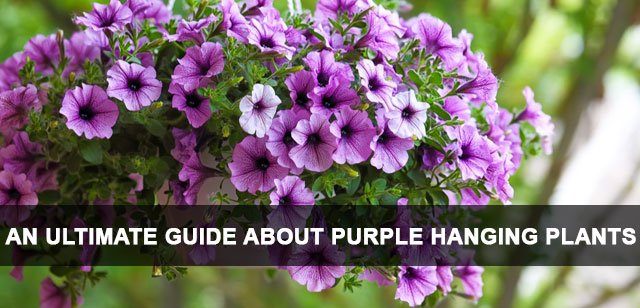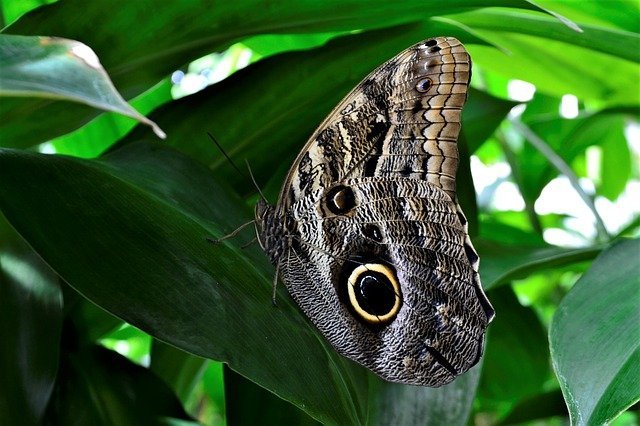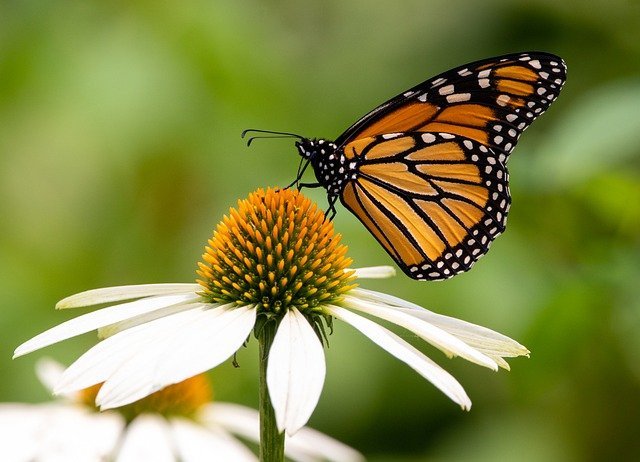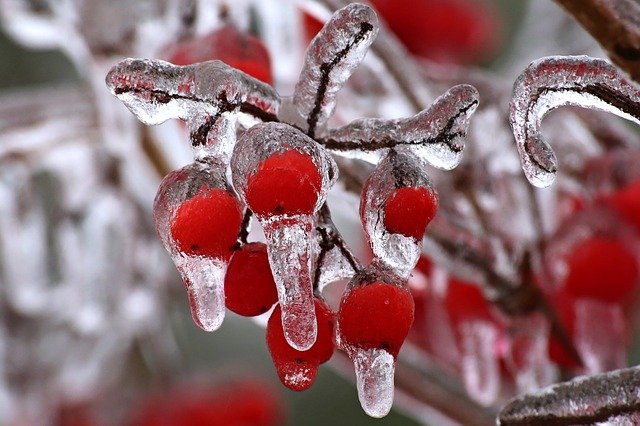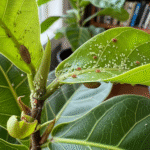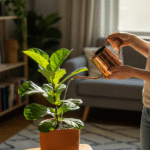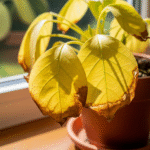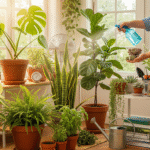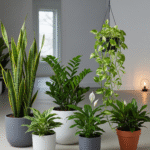Gardening is becoming one of the most loved hobbies all across the world and people want some attractive approach and thinking to shape up their gardens and homes.
The craze for planting and gardening can be observed as the world wants to know about how to decorate homes and gardens with beautiful hanging plants and flowers.
Relax! Take it easy. You will find all the queries and answers to your questions in this blog.
In these days of life, house plants have become a mandatory side to decorate your homes and gardens. People want to establish some different and unique things to decor their house hall, entrances, windows and balconies.
If you are looking to update the obvious interest in your home interior, why not shift to purple hanging plants instead of the usual green house plants?
Note: Hanging plants indoor and outdoor is one of the coolest options to decorate your hallways, entrances, windows and most viewed sides of your home. You can hang different types of plants that have beautiful and attractive colors. You can also match or contrast the color patterns with the interior of your home that will give an artistic look to your house.
PURPLE HANGING HOUSE PLANTS
As we know, purple is a symbol of royalty and culture. In purple you will find a range of different shades. If you look at most well- decor homes, you will see that they have some purple hanging flowers in their hallways and some of them are hanging outside the door steps.
Symbolically, the purple color represents success and admiration. In many religions, the purple color represents some ethics and culture. For example, in Chinese culture, purple violet represents good luck. If we further move on, you will come to know that in Christianity, purple violet personifies the call to prayer.
Purple hanging house plants have different shades to work with. However, you have to decide whether you love simple purple or violet purple. This will depend on how you want to visualize your home decoration.
TYPES OF HANGING PLANTS WITH PURPLE Foliage
Find the best type of hanging plants with purple foliage. Check this list of purple flowers for hanging baskets.
Purple Petunia
If you are looking for purple house plants that explore their tenderness in any weather condition, then you should plant a unique type of purple flower like the petunia. The lovely and adorable petunia is one of the most loved flowers that is very popular because of their blooming nature and capability to spread itself. It is an annual plant that boosts its length in summer, so you have to do cuttings of your petunia from time to time if you want blooming flowers. It maximizes its length of up to 4 feet in a basket. The purple petunia attracts most of the humming birds like butterflies.
5 Best Tips and tricks to grow purple petunia
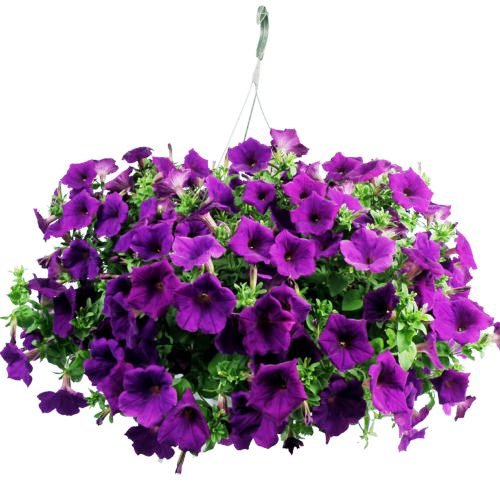
Nature and gardening lovers are spreading day by day! Most people have grown petunias in their gardens, but if you want to grow petunias in hanging baskets then be damn sure!! to read the following tips and tricks.
1. Over covering Hanging petunia
If you start covering your purple hanging basket with the usual covering, it applies force to control the growth of the petunias that can cause bad growth of beautiful purple petunias.
You don’t have to cover it with a heavy amount of soil because the petunia is a vigorous growing plant. Try to use 12“ baskets instead of oversize baskets to get blooming purple petunias.
2. Use of fertilizers.
Ever gardening expert will educate you to use fertilizers to get good results, but for all plants, it is not mandatory. Purple petunias need fertilization in summer season after their 3rd watering. The soil in the pot or in the hanging basket gets dry due to heat which pukes out all the nutrients and minerals that are important in the growth of flowers.
Fertilizers are important, but you have to use them according to the current condition of the plant.
3. Drainage of handing petunia.
To protect the roots of the hanging plant from decomposition, you need to find a pot that has multiple holes for drainage of water. It will maintain the freshness of the flower and maintain freshness for quite a long period.
4. Watering of hanging petunia.
Watering of the purple petunia is an important factor to be discussed properly because these flowering plants love the sun . Due to this, they rely on you to water them regularly. Don’t fill up the whole basket with water, try to water it 2 times a day instead of filling it up full at once.
5. Cutting of hanging petunia.
To enhance future blooms, cutting of hanging petunias is necessary to increase the growth of flowers.
Note: purple petunias are the best option for you to plant in a hanging basket. Their blooming flowers and spread of purple foliage make them one of the most beautiful bunches of happiness.
Wandering Jew (Tradescantia zebrine)
Striking your eyes with striped leaves, wandering Jew is one of the best options for hanging purple plants. This beautiful plant features sharp purple shade on new grown leaves and deep green shade on old grown leaves. You can use small hanging baskets to grow wandering Jew, thus making it a perfect purple hanging houseplant.
5 Best Tips and tricks to grow Wandering Jew
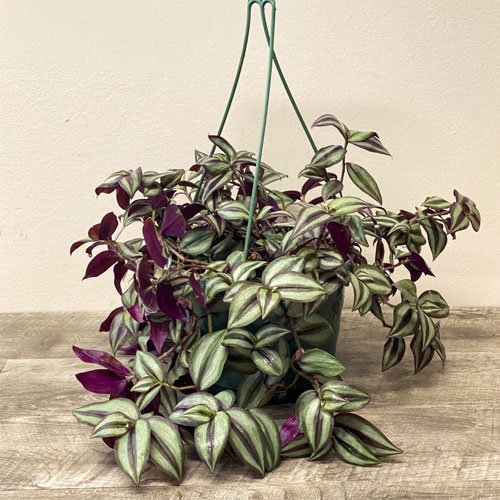
To grow Wandering Jew plants in a hanging basket, you should take care of the growth of this plant. So, I have decided to give you some 5 best tips and tricks for growing Wandering Jew plant in your pots.
1. Need of Sunlight.
This houseplant prefers sunlight to its beautiful purple foliage. You should hang this plant where they will get more sunlight. If this plant gets a minimum amount of sunlight, it’s leaves will look dry and dull.
2. Watering of hanging Wandering Jew.
These plants remain blooming if they get the right amount of water regularly. If you are growing this plant in hot weather conditions, try to keep the clay moist instead of keeping the soil dry for too long.
3. Use of fertilizers.
Interestingly, these plants don’t need fertilizers for better growth. However, you can use slow-processing fertilizers after 1 year. If I recommend, use water soluble fertilizers in your Wandering Jew plant.
4. Soil of hanging Wandering Jew.
Houseplant potting organic soil is best for Wandering Jew. You can easily fix this mixture of soil from any gardening shop.
5. Pruning of Wandering Jew.
To prevent Jew from becoming leggy, pruning of this plant becomes mandatory if you want a healthy and blooming appearance of this plant. You just have to pinch the tips of the stem that will , intern, make it bushed out.
Purple Shamrock
The Purple shamrock plant is one of the most beautiful purple hanging plants, commonly named as Oxalis Triangularis or false shamrock. It has dark purple foliage with magenta shades that grows in group of 3 eyes catching heart-shaped leaves.
False Shamrock folds its leaves when the night is cloudy and squeezes its petals like an umbrella. Spring season is the ideal season for growing purple shamrock.
Note: if you are growing purple shamrock in your hanging basket, place it on the sunny side where it will get the most amount of sunlight. Try to water it regularly to get its vibrant and attractive purple foliage.
5 Best Tips and tricks to grow Purple Shamrock
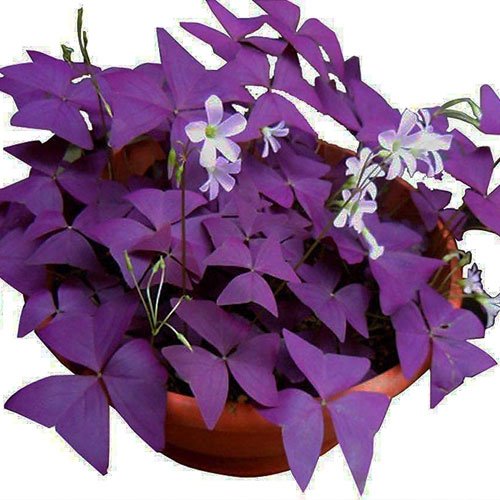
Purple Shamrock actively grows in hanging baskets and pots, but if you follow these tips and tricks, you will get a blooming Oxalis Shamrock.
1. Need of sunlight.
If you don’t want your purple shamrock to become weak and leggy, place it in a sunny shade. These plants grow well under the sunlight. Countries where the heat of sunlight splashes more can grow this plant but try to cover it with some protective layer.
2. Watering of hanging purple shamrock.
Purple shamrock needs water on a daily basis. You should maintain the moisture in the soil to get blooming shades of purple foliage of this plant. This plant can tolerate drought soil but in the growing season, it needs regular watering.
3. Use of fertilizers
You can use water-fertilizer for purple shamrock during the spring season for healthy growth. You can also use slow-release fertilizer and some soil compost to get healthy wealthy growth.
4. Soil of hanging purple shamrock
Hanging purple shamrock needs sandy soil to grow properly, but make sure the hanging pot should be well-draining. If moist remains on the roots for too long, it can cause the roots to rot.
5. Temperature and humidity
Most probably, oxalis shamrock likes to grow at a temperature between 70 to 80 degrees F. These plants can also like to grow in indoor room temperature. If you are planting this plant indoors, try to place it where they can’t get the waves of the heater or air conditioner.
Coleus purple plants
If you have grown coleus before, you should know how beautiful this plant looks in your garden, but the main question is :can this plant grow in hanging pots or baskets?
Well, the answer is “yes”. This plant is the most iconic plant that you can grow in hanging baskets and pots.
Painted Nettle is one of the most loved varieties of coleus plant and flourishes its blooming green, purple and maroon colors in your indoors. You can grow this plant easily in hanging pots. The petals of coleus are rich with vibrant colors that your eyes will stuck on them to see the blooming colors of this beautiful variety of coleus plant.
5 Best Tips and tricks for growing Coleus purple plants

To get blooming Coleus, follow these tips and tricks.
1. Need of sunlight.
This houseplant prefers sunlight to bloom its beautiful green, purple and maroon foliage. You should hang this plant where they will get proper sunlight, but they can bare partial shades if they are placed under some roof.
2. Watering of coleus purple plant.
You should water coleus plants regularly, as the experts say that you should water them twice a day if you want the beautiful vibrant colors of coleus, but if you don’t do so, they will look dull and leggy.
3. Use of fertilizers.
You can use water-fertilizers every week in coleus purple plants during the spring season for healthy growth. You can also use slow-release fertilizer and some soil compost to get quick growth.
4. Temperature and humidity
Well, coleus purple plants like to grow at a temperature between 70 to 100 degrees F. These plants can also like to grow in indoor room temperature. If you are planting this plant indoors, try to place it where they can’t get the waves of the heater or air conditioner.
5. Soil of coleus purple plant.
Just go with simple soil that is rich with nutrients. Try to use sandy soil because it remains moist for a long time.
Purple Queen
Trying to search for one of the best purple hanging houseplants? Well, you should look for planting purple Queen or Tradescantia Pallida.
This plant helps to landscape your indoors and outdoors as it is the coolest option for you to grow in your household because these plants grow very fast and involve themselves with any kind of environment. It becomes more beautiful when a group of vivid pink blooms in between lace-shaped leaves.
The handling of the purple Queen is quite easy and if you are a beginner at gardening, you can easily take care of this purple foliage plant.
It has lace-shaped leaves that can thrive up to 6“ long and fill up any space in which they have been placed.
5 Best Tips and tricks to grow Purple Queen
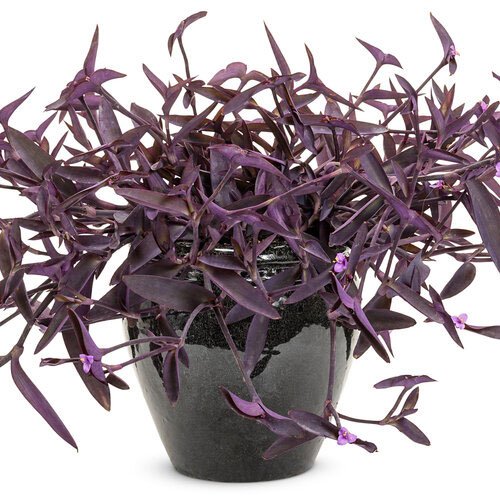
These 5 best tips and tricks will guide you about what things should be according to the plant requirements to get better and healthy growth of the Purple Queen plant.
1. Need of sunlight.
The Purple queen needs a lot of light to spread its vibrant blooming foliage, but if you are planting these plants indoors, try to place them near your windows where these plants will get enough light.
2. Watering of Purple Queen.
The Indoor Purple Queen should be moist during hot summer days. Although, this plan can tolerate dryness, I recommend you water it deeply on a daily basis.
In case of intensive sunlight, water them frequently to avoid the dullness of purple foliage.
3. Temperature and humidity.
The room temperature is ideal if you are planting indoors. However, this plant thrives at a temperature between 50 to 80-degrees F.
In freezing conditions, this can die, but if you cove it properly, it will last long.
Humidity cannot affect this plant as long as they are getting fresh air.
4. Use of fertilizers.
The use of fertilizers is not necessary if you are taking good care of this plant. However, adding fertilizer will not affect this plant. Instead, it influences more flowering and blooms vibrant colors.
During spring and summer, you should add slow-release fertilizer twice a month.
5. Soil
The Purple queen likes to grow in loamy soil with a good drainage system. You can also mix compost soil for sharp growth.

